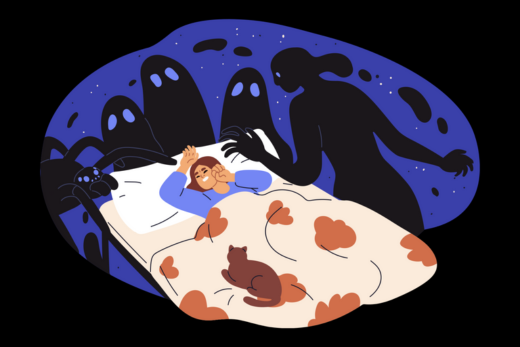¿Te has despertado alguna vez de un sueño muy vívido justo antes de que te venga la regla? No estás sola. A muchas personas les pasa. sueños menstrualesEsos sueños vívidos, a menudo extraños, que pueden perturbar el sueño. Estos sueños pueden abarcar desde emocionantes aventuras hasta pesadillas espeluznantes, y para algunos, al despertar se sienten más cansados que descansados.
Pero, ¿qué hay detrás de estos sueños tan intensos? La respuesta reside en los cambios hormonales que se producen a lo largo de tu vida. ciclo menstrualA medida que tu cuerpo se prepara para la menstruación, aumentan hormonas como la progesterona, lo que provoca cambios en la temperatura corporal y patrones de sueñoEstos cambios pueden dificultar conseguir un sueño reparador e ininterrumpido, especialmente durante el día. fase lútea de tu ciclo—el período previo a tu menstruación.
En este blog, analizaremos la ciencia detrás de sueños menstruales, explica cómo tu El ciclo menstrual afecta la calidad del sueñoy comparte consejos para mejorar tu descanso. Con herramientas como anillos inteligentes Para monitorizar el sueño, podrás comprender mejor tus patrones de sueño y mejorar el descanso durante esta fase de tu ciclo.
RingConn Gen 2
La ciencia detrás de los sueños menstruales y cómo los cambios hormonales afectan el sueño
Cambios hormonales durante la fase lútea
Durante el fase lútea (la segunda mitad de tu ciclo menstrual(Después de la ovulación y antes de la menstruación), la hormona progesterona aumenta mientras que el estrógeno disminuye. Este cambio hormonal prepara al cuerpo para la menstruación, pero también afecta a diversos aspectos de la salud, incluyendo calidad del sueño.
A medida que aumentan los niveles de progesterona, la temperatura corporal se eleva, lo que dificulta conciliar un sueño profundo y reparador. Esta alteración puede provocar una menor sensación de descanso y una mayor probabilidad de despertarse durante la noche, especialmente durante la fase REM (movimiento ocular rápido), la etapa en la que se producen los sueños más vívidos.
Temperatura corporal y trastornos del sueño
El aumento de la temperatura corporal causado por la progesterona puede interferir con la capacidad del cuerpo para enfriarse durante el sueño. Esto dificulta la conciliación del sueño. sueño profundo, la etapa en la que tu cuerpo realiza funciones reparadoras cruciales. Desde sueño REM También se ve afectada por los cambios de temperatura, lo que puede provocar un sueño fragmentado y sueños más vívidos, a menudo inquietantes.
El impacto del sueño REM en los sueños menstruales
sueño REM es la etapa del sueño en la que se producen los sueños más vívidos. Las interrupciones de esta fase durante el sueño fase lútea Puede provocar que te despiertes con más frecuencia durante o inmediatamente después de un sueño, aumentando las probabilidades de recordarlo con detalle. Esto explica por qué tus sueños durante este tiempo pueden parecer más intensos o extraños, cuando te despiertas durante sueño REMEl contenido del sueño tiende a quedarse más tiempo en la memoria.
Factores emocionales y psicológicos en los sueños menstruales
Las fluctuaciones hormonales también afectan tu estado emocional, haciéndote sentir más sensible o reactivo, lo cual puede influir en el contenido de tus sueños. Por ejemplo, si te sientes ansioso, estresado o emocionalmente intenso, estas emociones podrían manifestarse en tus sueños. Podrías soñar con sentirte atrapado, desprevenido o abrumado, reflejando así tus ansiedades durante el día.

Cómo las fluctuaciones hormonales alteran el sueño y contribuyen a los sueños relacionados con la menstruación
El papel de la progesterona en los trastornos del sueño
Durante el fase lúteaLos niveles de progesterona aumentan significativamente. Si bien esta hormona ayuda a preparar el cuerpo para el embarazo, también tiene un efecto sedante que produce somnolencia. Sin embargo, su efecto sobre la temperatura corporal —que aumenta la sensación de calor— puede dificultar alcanzar un sueño profundo y reparador. Como resultado, es posible que experimentes un sueño más ligero y menos reparador.
El impacto del estrógeno en el sueño y sus trastornos
Por otro lado, el estrógeno desempeña un papel clave en el apoyo sueño REM y estabilizando el ritmo circadiano durante la primera mitad del ciclo (la fase folicular). A medida que disminuye el estrógeno durante la fase lúteaLas interrupciones del sueño REM contribuyen a un sueño más fragmentado, lo que puede conducir a alucinaciones más vívidas e intensas. sueños menstruales.
Sueño fragmentado y su impacto emocional
La combinación de una temperatura corporal más cálida y niveles reducidos de estrógeno durante el fase lútea puede provocar un sueño fragmentado. Esto reduce la calidad del sueño y conlleva despertares más frecuentes, especialmente durante la noche. fase REMComo te despiertas con más frecuencia durante los sueños, es probable que los recuerdes vívidamente. Estos sueños emotivos también pueden dejarte aturdido o irritable al día siguiente.
Seguimiento del sueño y los ciclos menstruales con anillos inteligentes

Controla tu sueño con anillos inteligentes
Si tienes dificultades con sueños menstruales o trastornos del sueño durante el fase lútea, llevar un registro de tu sueño puede ser una herramienta útil.
Anillos inteligentes como
Seguimiento del ciclo menstrual para obtener información sobre cómo dormir mejor
Además del seguimiento del sueño,
Información personalizada para mejorar el sueño y la salud menstrual
Una de las mejores cosas de
RingConn Gen 2 Air
Consejos para mejorar el sueño durante la fase lútea
- Crea un ambiente de sueño fresco y confortable Dado que la progesterona provoca un aumento de la temperatura corporal, intenta mantener un ambiente fresco para dormir. Una habitación fresca favorece un sueño más profundo y te ayuda a mantenerte dormida. sueño REM Sin despertarte durante sueños vívidos. Usa ventiladores, aire acondicionado o sábanas refrescantes para que tu habitación sea más cómoda.
- Mantén un horario de sueño regular. Mantener una rutina de sueño regular puede ayudar a estabilizar el reloj biológico. Acostarse y levantarse a la misma hora todos los días, incluso los fines de semana, ayuda a regular el ritmo circadiano, facilitando conciliar el sueño y dormir toda la noche. fase lútea.
- Evite los estimulantes antes de acostarse La cafeína, el alcohol y otros estimulantes pueden interferir con tu capacidad para conciliar el sueño, especialmente durante la noche. fase lúteaLa cafeína puede aumentar la frecuencia cardíaca y la temperatura corporal, mientras que el alcohol altera sueño REM, lo que dificulta conciliar el sueño. Limita el consumo de estas sustancias en las horas previas a acostarte.
- Incorpora técnicas de relajación antes de acostarte. Dado que las emociones intensas contribuyen a una mayor intensidad sueños menstrualesConsidera incorporar prácticas de relajación a tu rutina nocturna. La respiración profunda, la meditación o el yoga suave pueden ayudarte a calmar la mente y preparar el cuerpo para un sueño reparador.
- Haga ejercicio con regularidad (pero no demasiado cerca de la hora de acostarse). La actividad física regular puede mejorar la calidad del sueño y ayudar a equilibrar las hormonas. Eso sí, ten cuidado de no hacer ejercicio demasiado tarde, ya que esto puede acelerar el ritmo cardíaco y dificultar conciliar el sueño.
- Utiliza el seguimiento del sueño para perfeccionar tu estrategia de sueño Utilizando un anillo inteligente como
RingConn puede ayudarte a realizar un seguimiento de cómo el fase lútea afecta a tus patrones de sueño. Con datos sobre tus fases de sueño y temperatura corporal, puedes realizar ajustes para mejorar tu descanso.
Conclusión: Toma el control de tu sueño y tu salud menstrual
Experimentando sueños menstruales es una parte normal de ciclo menstrual, gracias a las fluctuaciones hormonales que ocurren durante el fase lúteaEstos sueños vívidos y a veces perturbadores suelen estar relacionados con cambios en patrones de sueño, como un aumento de la temperatura corporal y alteraciones en sueño REMPero con el conocimiento y las herramientas adecuadas, puedes gestionar estos cambios y mejorar tu calidad del sueño.
Al rastrear tu ciclo menstrual y patrones de sueño con herramientas como
Toma el control de tu sueño y salud menstrual Haciendo un seguimiento de tu ciclo hoy.Empieza a usar




Deja un comentario
Este sitio está protegido por hCaptcha y se aplican la Política de privacidad de hCaptcha y los Términos del servicio.